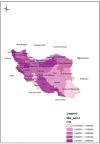Epidemiology of Guillain-Barré Syndrome in Iranian Children Aged 0-15 Years (2008-2013)
- PMID: 34782839
- PMCID: PMC8570621
- DOI: 10.22037/ijcn.v15i4.25087
Epidemiology of Guillain-Barré Syndrome in Iranian Children Aged 0-15 Years (2008-2013)
Abstract
Objective: Guillain-Barré Syndrome (GBS) is an acute inflammatory polyneuropathy characterized by a rapid progressive symmetric weakness. The GBS is the most common cause of acute flaccid paralysis (AFP) in most parts of the world. This study was carried out to investigate the epidemiological features of GBS in Iranian children.
Materials & methods: The data were extracted using the AFP surveillance system that is a national screening program to detect all cases of AFP aged 0-15 years around the country. National Population Statistics data and AFP demographic data during 2008-2013 intervals were obtained from the relevant authorities in the Ministry of Health in Iran. The GBS cases were then extracted from the aforementioned database. The Chi-square test and Fisher's exact test were used for statistical analysis.
Results: A total of 1884 cases of GBS were identified in the study period, and the average annual incidence rate was 1.72 per 100,000 individuals. The highest incidence rate was within the range of 0-5 years. There was no statistically significant relationship between the incidence of GBS and the season in the whole country.
Conclusion: High costs of GBS treatment, morbidity and occasional mortality, and number of new cases, which is estimated to be approximately 300 individuals per year, need the particular attention of the health system.
Keywords: Children; Epidemiology; Guillain-Barré Syndrome; Incidence; Iran.
Figures



References
-
- McGrogana A, Madleb GC, Seamanb HE, de Vries CS. The Epidemiology of Guillain-BarréSyndrome Worldwide:a Systematic Literature Review. Neuroepidemiology. 2009;32:150–63. - PubMed
-
- Govoni V, Granieri E. Epidemiology of the Guillain-Barre syndrome. Curr Opin Neurol. 2001;14:605–613. - PubMed
-
- Hughes RAC, Rees JH. Clinical and epidemiologic features of Guillain-Barre syndrome. J Infect Dis. 1997;176 :S92–S98. - PubMed
-
- Rosen AB. Guillain-Barre´ Syndrome. Pediatrics in Review April. 2012;33(4):164–71. - PubMed
-
- Congia S, Melis M, Carboni MA. Epidemiologic and clinical features of the Guillain-Barre´ syndrome in Sardinia in the 1961–1980 periods. Acta Neurol. 1989;11:15–20. - PubMed
LinkOut - more resources
Full Text Sources
